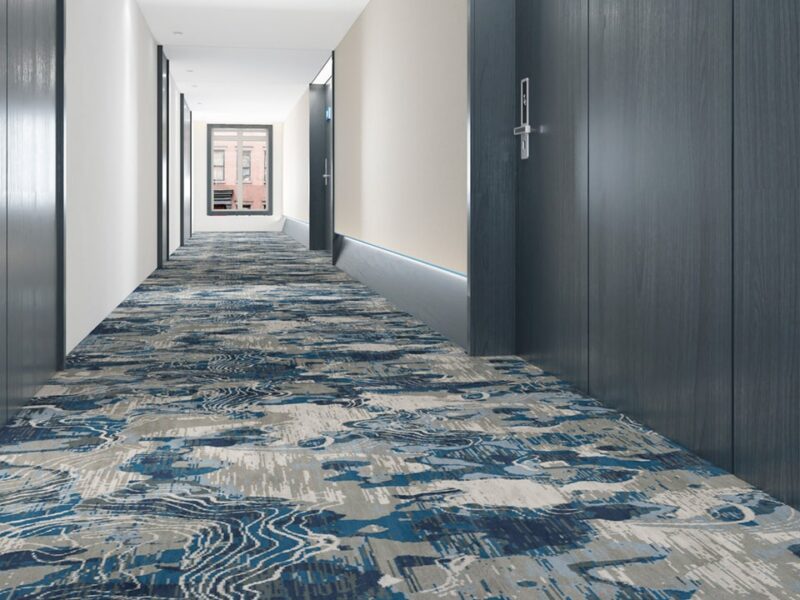
The humble carpets, one of humanity’s earliest crafts, is far more than just a floor covering. It represents human civilization, embodying national, folk, and popular arts, and leaving us with rich cultural memories. As a critical medium in interior design, a carpet eloquently conveys the designer’s vision, seamlessly integrating with and enhancing the overall spatial environment. Whether through elegant patterns or vibrant colors, these woven pieces communicate profound humanistic sentiment and distinct artistic statements.
Today, in the design of star-rated and boutique hotels, the integration of the hotel carpet into the comprehensive furniture and furnishing system marks a significant trend. This shift is key to elevating the spatial environment and increasing its artistic added value.
I. The Hotel Carpet as a Craft and Art Form
As a piece of refined craftsmanship, the hotel carpet operates on dual tracks: functionality and aesthetics, as well as a subordinate and an independent identity.
1. Functional Utility
Beyond its primary role as a floor covering, a carpet offers essential practical benefits:
- Air Quality: It acts as a dust trap, purifying the air.
- Acoustics: It excels at sound absorption and noise reduction.
- Comfort & Insulation: It provides moisture protection, thermal insulation, and a soft, comfortable underfoot experience.
2. Aesthetic & Experiential Function
A carpet’s core aesthetic role is to beautify and adorn the environment. The process of appreciation typically follows a sensory sequence: Color first catches the eye, followed by Pattern, and finally, the Tactile experience (texture). This progression—from visual and psychological perception to behavioral acceptance—is how the beauty of the design is truly realized.
3. Subordinate Harmony
The hotel carpet, along with furniture and textiles, forms the primary components of interior furnishings. These elements are designed to share similarities in style, texture, tone, and craftsmanship. A carpet is never isolated; it exists within the interior context, striving for a harmonious and unified relationship with its surrounding environment. Design, in this sense, is the art of solving these relational puzzles.
4. Artistic Independence
This is where the aesthetic function truly shines. Hotel carpets can be classified as standalone works of art. Hand-knotted carpets, for instance, are celebrated for their unique artistry, becoming important furnishings, valuable collectibles, and a distinct artistic language within interior design.
II. The Carpets as Floor Covering, Textile, and Furniture
The diverse and fluid classification of the carpet makes it a powerful vehicle for expressing emotion and artistic individuality in environmental design. When designing a single carpet product, the concept must be rooted in large-scale environmental art. A holistic approach is essential, managing the relationship between the carpet and the environment from both macro (overall space) and micro (specific area) perspectives.
- As a Background (Surface): The hotel carpet acts as a “surface” that, enclosed by other interfaces, establishes a background and scenic relationship. In this peaceful state, it resonates harmoniously with the furniture and textiles above it.
- As a Focal Point (Dot): Alternatively, a carpet can detach itself from the background to emphasize contrast, becoming a “dot” of visual interest—a “carpet on a carpet” or a “point decoration.”
The interaction of the carpet’s “dot” and “surface” elements is inextricably linked to the spatial form. In hotel lounge areas, banquet halls, and corridors, carpets of the same design and color must be subtly adjusted to accommodate variations in spatial form and transitions. Crucially, only by maintaining continuity can the dot, line, and surface elements of the hotel carpet connect, allowing the carpet to serve as a powerful bond—transmitting information, connecting spaces, and uniting emotional experiences.
III. The Integrated Design Approach
The overall positioning of the interior environmental art design dictates the quality, material, and color design of the hotel carpet. Therefore, the hotel carpet design process must be initiated early, starting at the conceptual phase, and the carpet professional should be fully integrated into the hotel design system.
- Machine-Woven Carpets: These designs are trending toward modern simplicity in their properties and ornamentation, offering high-quality, efficient solutions.
- Handmade Carpets: These pieces amplify their artistic uniqueness in terms of independence and artistry. Simultaneously, building upon heritage, handmade carpets continue to innovate and evolve, cementing their place as significant contemporary art collectibles.

